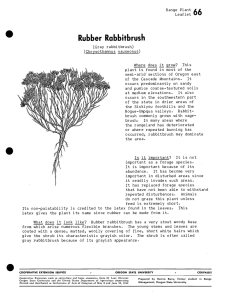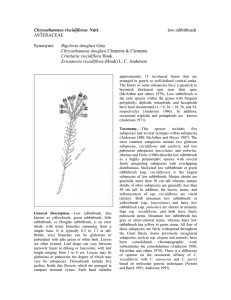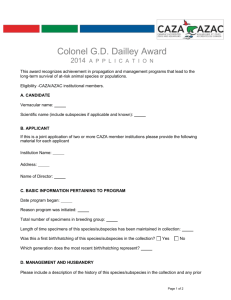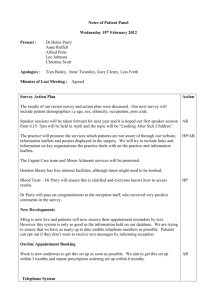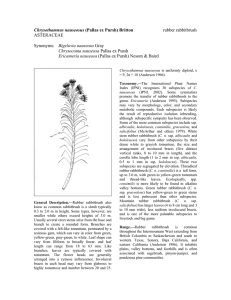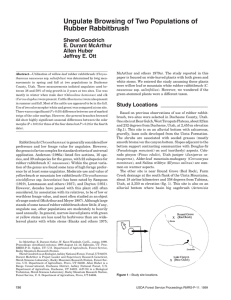Chrysothamnus parryi Parry rabbitbrush ASTERACEAE
advertisement
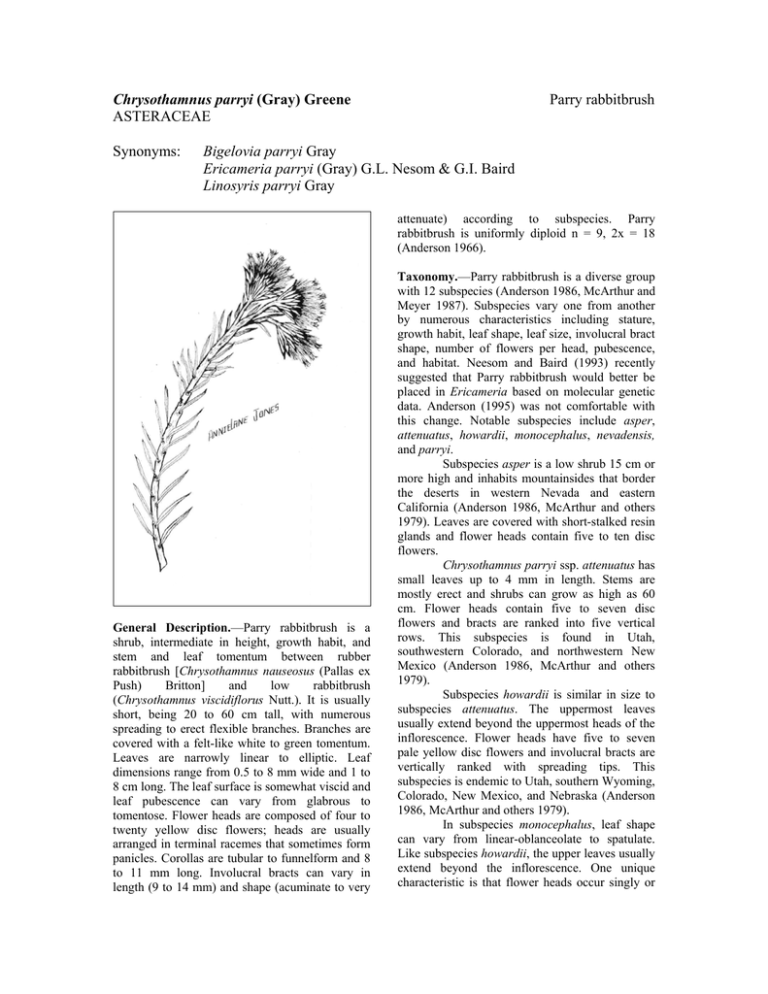
Chrysothamnus parryi (Gray) Greene ASTERACEAE Synonyms: Parry rabbitbrush Bigelovia parryi Gray Ericameria parryi (Gray) G.L. Nesom & G.I. Baird Linosyris parryi Gray attenuate) according to subspecies. Parry rabbitbrush is uniformly diploid n = 9, 2x = 18 (Anderson 1966). General Description.—Parry rabbitbrush is a shrub, intermediate in height, growth habit, and stem and leaf tomentum between rubber rabbitbrush [Chrysothamnus nauseosus (Pallas ex Push) Britton] and low rabbitbrush (Chrysothamnus viscidiflorus Nutt.). It is usually short, being 20 to 60 cm tall, with numerous spreading to erect flexible branches. Branches are covered with a felt-like white to green tomentum. Leaves are narrowly linear to elliptic. Leaf dimensions range from 0.5 to 8 mm wide and 1 to 8 cm long. The leaf surface is somewhat viscid and leaf pubescence can vary from glabrous to tomentose. Flower heads are composed of four to twenty yellow disc flowers; heads are usually arranged in terminal racemes that sometimes form panicles. Corollas are tubular to funnelform and 8 to 11 mm long. Involucral bracts can vary in length (9 to 14 mm) and shape (acuminate to very Taxonomy.—Parry rabbitbrush is a diverse group with 12 subspecies (Anderson 1986, McArthur and Meyer 1987). Subspecies vary one from another by numerous characteristics including stature, growth habit, leaf shape, leaf size, involucral bract shape, number of flowers per head, pubescence, and habitat. Neesom and Baird (1993) recently suggested that Parry rabbitbrush would better be placed in Ericameria based on molecular genetic data. Anderson (1995) was not comfortable with this change. Notable subspecies include asper, attenuatus, howardii, monocephalus, nevadensis, and parryi. Subspecies asper is a low shrub 15 cm or more high and inhabits mountainsides that border the deserts in western Nevada and eastern California (Anderson 1986, McArthur and others 1979). Leaves are covered with short-stalked resin glands and flower heads contain five to ten disc flowers. Chrysothamnus parryi ssp. attenuatus has small leaves up to 4 mm in length. Stems are mostly erect and shrubs can grow as high as 60 cm. Flower heads contain five to seven disc flowers and bracts are ranked into five vertical rows. This subspecies is found in Utah, southwestern Colorado, and northwestern New Mexico (Anderson 1986, McArthur and others 1979). Subspecies howardii is similar in size to subspecies attenuatus. The uppermost leaves usually extend beyond the uppermost heads of the inflorescence. Flower heads have five to seven pale yellow disc flowers and involucral bracts are vertically ranked with spreading tips. This subspecies is endemic to Utah, southern Wyoming, Colorado, New Mexico, and Nebraska (Anderson 1986, McArthur and others 1979). In subspecies monocephalus, leaf shape can vary from linear-oblanceolate to spatulate. Like subspecies howardii, the upper leaves usually extend beyond the inflorescence. One unique characteristic is that flower heads occur singly or in pairs rather than forming racemes. Flower heads contain five or six disc flowers subtended by obscurely ranked involucral bracts. This subspecies occurs in high mountains between 790 and 3,400 m in eastern California and western Nevada. Subspecies nevadensis is comprised of small shrubs up to 60 cm in height. Leaves are linear to linear-oblanceolate and covered with resin or gray tomentum. The uppermost leaves rarely extend beyond the inflorescence. Flower heads contain four to six yellow disk flowers and are subtended by ranked involucral bracts with slender recurved tips. Subspecies nevadensis occurs on dry mountainsides from eastern California to eastern Nevada, southwestern Utah, and Northern Arizona, being most common on the eastern slopes of the Sierra Nevada (Anderson 1986, McArthur and others 1979). Subspecies C. parryi ssp. parryi consists of low shrubs with erect branches and can be as tall as 76 cm. The uppermost leaves usually extend beyond the inflorescence. Flower heads include 10 to 20 disc flowers and are subtended by obscurely ranked bracts with attenuate tips. This subspecies grows on dry hillsides and plains in central Nevada, southern Utah, south-central Wyoming, western Colorado, and northern New Mexico (Anderson 1986, McArthur and others 1979). Anderson (1970) made a case for this taxon being the most primitive of all Chrysothamnus. Parry rabbitbrush in the form of C. parryi ssp. attenuatus has been implicated in the parentage of the putative stabilized hybrid species C. nauseosus ssp. uintahensis Anderson 1984). Range.—The range of Parry rabbitbrush extends from California in the west, to western Nebraska in the east, and from Wyoming in the north, to New Mexico and Arizona in the south. Subspecies, however, may be more geographically restricted. Within its range, Parry rabbitbrush may be found at elevations between 790 and 3,400 m. covered with long, shaggy, oppressed hairs. We presume there are about 1,600 cleaned achenes per gram and that they have good fertility as is the case for other Chrysothamnus species (Deitschmann and others 1974). Achenes are wind disseminated in late fall or winter. In addition to sexual reproduction, Parry rabbitbrush has been observed to spread through underground roots (Paulsen and Miller 1968, McArthur and others 1979). We are unaware of seed germination data. Growth and Management.—Seed germinates in the early spring and seedlings become established during the following spring and summer. Plants generally mature within 5 years and typically live 15 to 20 years. Paulsen and Miller (1968) reported that, when necessary, Parry rabbitbrush can be controlled by the herbicide Tordon®.1 Benefits.—Although Parry rabbitbrush is a component of western uplands, it is spotty in distribution and usually sparse in population density. It has some importance as a browse source in those areas where it is locally abundant. Some subspecies of Parry rabbibrush, including C. parryi ssp. asper and C. parryi ssp. monocephalus, are particularly attractive plants and have horticultural potential as ornamentals. References Anderson, L.C. 1966. Cytotaxonomic studies in Chrysothamnus (Asterae, Compositae). American Journal of Botany 53: 204-212. Anderson, L.C. 1970. The karyotype of Chrysothamnus parryi ssp. parryi and its implication. Transactions of the Kansas Academy of Science 72: 399-401. Anderson, L.C. 1984. Chrysothamnus nauseosus ssp. uintahensis: a stabilized hybrid. Great Basin Naturalist 44:416-420. Ecology.—Parry rabbitbrush grows on dry, open foothills and mountains. Precipitation throughout its range generally exceeds 380 mm. Parry rabbitbrush tends to increase on overgrazed or otherwise disturbed areas. Populations are usually smaller and more scattered than those of more common species, such as rubber and low rabbitbrushes. Anderson, L.C. 1986. An overview of the genus Chrysothamnus. In: E.D. McArthur and B.L Welch, comps. Proceedings—symposium on the biology of Artemisia and Chrysothamnus; 1984 July 9-13, Provo, UT. General Technical Report INT-200. U.S. Department of Agriculture, Forest Service, Intermountain Research Station, Ogden, UT: 29-45. Reproduction.—Parry rabbitbrush flowers from July to September and seed matures in October and November. Achenes are 5 to 6 mm long and 1 Use of trade names does not imply endorsement of the U. S. Department of Agriculture Anderson, L.C. 1995. The ChrysothamnusEricameria connection (Asteraceae). Great Basin Naturalist 55: 84-88. Deitschman, G.H., K.R. Jorgensen, and A.P. Plummer. 1974. Chrysothamnus. In: C. S. Schopmeyer, Tech. Coord., Seeds of Woody Plants of the United States. Agriculture Handbook 450. Washington, DC, U.S. Department of Agriculture, Forest Service. p. 326-328. McArthur, E.D., A.C. Blauer, A.P. Plummer, and R. Stevens. 1979. Characteristics and hybridization of important intermountain shrubs. III. Sunflower family. Research Paper INT-220. U.S. Department of Agriculture, Forest Service, Intermountain Forest and Range Experiment Station, Ogden, UT. 82 p. McArthur, E.D. and S.E. Meyer. 1987. A review of the taxonomy and distribution of Chrysothamnus. In: K.L. Johnson, ed. Proceedings of the Fourth Utah Ecology Workshop; 1986 September 17-18, Cedar City, UT. College of Natural Resources, Utah State University, Logan, UT. p. 9-18. Nesom, G.L. and G.I. Baird. 1993. Completion of Ericameria (Asteraceae: Asterae), diminution of Chrysothamnus. Phytologia 75: 74-93. Paulsen, H.A., Jr. and J.C. Miller. 1968. Control of Parry rabbitbrush on mountain grasslands of Western Colorado. Journal of Range Management 21: 165-177. _________________________________________ E. Durant McArthur and Jeffrey R. Taylor, Research Geneticist and Biological Technician, U.S. Department of Agriculture, Rocky Mountain Research Station, Shrub Sciences Laboratory, 735 N. 500 E., Provo, UT 84606-1856
